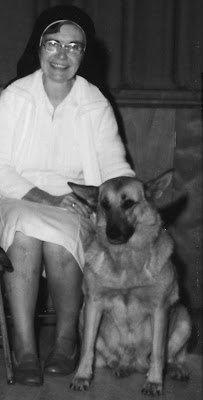
Mrs. Mahoney and Maude Smith Rundall in front of the Wassaic Schoolhouse
TWO FOR THE ROAD
By Gerry Holzman
Even though Maude Rundall and Herb Akleman were a highly unlikely pair, they remain forever linked in my memory because of their mutual disdain for the law.
Mrs. Rundall., a very proper married woman, could easily be spotted as she poked along the roads of Amenia in her 1939 gray Plymouth two-door sedan. Herb Akelman, the epitome of a post-World War II unmarried playboy, could usually be heard before he was seen as he roared around that same town in a red 1949 Oldsmobile convertible with dual exhausts.
Indian Rock board member, Ellen Walsh, got a letter back from Lynne Akelman (Herb Akelman’s daughter) Ellen sent her an Amenia Cookbook and Ellen tells us that Lynn loved the cookbook and shared the pictures,stories, and recipes with Herb. Herb will not own up to the car story, but does remember coaching the football team.

At the time of the incidents referred to above, he was tall, thin and in his early twenties. She was short, plump and in her middle fifties. He was the son of our local dry cleaner and she was the Superintendent of Schools. He pitched for the Town baseball team and was known to enjoy the post-game festivities even more than the game itself. She presided over a ladies church group and was often complemented on the beauty of her flower garden.
From this brief catalog of characteristics it is obvious that Herb Akelman and Maude Rundall had little in common. But, because of their crimes, separate crimes in which I was innocently involved, I am unable to remember one of them without being reminded of the other.
The memory link that connects them is quite clear—it is the Traffic Laws of the State of New York. They both violated one of these laws while I was a passenger, you might even say a potential victim, riding in their cars.
We'll start with Herb Akelman. His crime involved not only me but nearly half of the Amenia High School football team.
It was the afternoon of the Pine Plains--Amenia game and Herb, a volunteer assistant coach, had offered to transport some of us players to Pine Plains, a distance of about 15 miles. It was decided that he would drive the linemen in his red Oldsmobile convertible while our regular coach would take the remainder of the team in his plodding Ford station wagon.
In those days in Amenia, it was possible to transport an entire football team in two cars, not because cars were larger but because teams were smaller. Centralized school districts were not yet widespread in upstate New York so high schools with fewer than 100 students were quite common. If such a school wanted to play football, it usually was six-man football; the Amenia team, including substitutes, consisted of nine “brawny” boys.
Herb took four of us in his red convertible. As we tooled along rural Route 22 with the top down, Herb shouted back to us. "Any of you guys every go 100 miles an hour?" Without waiting for an answer, he continued shouting over the rapidly increasing wind, "Well, hang on tight because we’re gonna do it now."
I remember looking over his shoulder at the speedometer and saw that the needle was nearing 80. It moved past eighty and began inching toward the 90 mark. I turned away and looked out the back. Never have I seen a road disappear more rapidly--trees and pavement were merged into a gray-green blur. That blur mingled with the roaring wind to intensify what quickly developed into an exhilarating sense of motion. It was as if we were experiencing all the thrilling excitement of a roller-coaster ride without any of its stomach-flipping terror.
In the midst of all this came a jubilant shout from the front seat, "We did it!”
Herb took his foot off the accelerator, and the speedometer returned to a respectable fifty. It was over; we had broken the 100 mile an hour barrier--and the New York State traffic law.
I have absolutely no memory of any remaining part of the afternoon. I assume we arrived safely in Pine Plains and either won, lost or tied the game.
I've never gone 100 miles an hour since then although once I did nudge the 80 mark. But that wasn’t in a red convertible with the top down on a perfect fall day in upstate New York.
Now Maude Rundall's criminal act was certainly not as daring nor as willful as Herb's but I’m sure it was a serious motor vehicle violation nonetheless. It grew out of an eighth grade field trip to Hyde Park, a visit which took place took place shortly after President Franklin D. Roosevelt's death.
Mrs. Rundall and the Principal, Mr. Lonsdale (who also taught Geometry, Trigonometry, Chemistry and Physics) were the drivers on this round-trip of some sixty miles. Mrs. Rundall drove her old gray Plymouth, Mr. Lonsdale drove his relatively new Buick. And into those two automobiles. they somehow crammed fourteen eighth graders--each one of us carrying a good-sized lunch box, a notebook and an ink pen.
How they did it, I'll never know. Since it was before the days of seat belts and instant litigation, they probably saw no harm or worry in it. I clearly recall being in the front seat of Mrs. Rundall’s car with at least two other kids sharing that place of honor with me. And only God and Mrs. Rundall knew how many of my class mates were packed into the rear of that two-door gray Plymouth. As for Mr. Lonsdale, I’m sure his formidable background in Physics enabled him to successfully stuff great quantities of the remaining students into his relatively new Buick.

But somehow, we did manage to arrive safely and had a truly memorable visit to FDR"s ancestral home--I still clearly recall the grandeur of the house and the magnificent view of the Hudson it commanded. Most of us listened attentively to Mrs. Rundall who acted as our guide and we dutifully took notes in our loose-leaf notebooks with our ink pens. I even made a crude sketch in my notebook of a jeweled, ivory handled sword that had been given to FDR by an Arab sheik.
When we finished our tour, we had our promised picnic lunch on the gently slopping lawn. After lunch, all fourteen of us agreeably resumed our cramped places in the relatively new Buick and the old gray Plymouth and had an uneventful trip home. (I strongly suspect that my life-long interest in history was awakened by that visit)
But Maude Rundall, Superintendent of Schools for the Union Free District of Amenia, aided and abetted by Principal Howard Lonsdale, surely must have broken some significant Motor Vehicle Law. You simply can't safely put two adults and fourteen eighth graders, each one carrying a lunch box, a loose-leaf notebook and an ink pen, inside an old gray Plymouth two-door sedan and a relatively new Buick coupe
So, Herb Akelman and Maude Rundall, even though you stand before the bar of memory as indisputable criminals whose irresponsible acts clearly endangered the life of a young, innocent schoolboy, I forgive you. And with the wisdom granted me by the twin gods of Retrospection and Introspection, I thank you.
Two For The Road –(1,175 words)
©2007, Gerry Holzman
escarousel@aol.com Indian Rock Schoolhouse Association Vice President, Ellen Walsh, sends this special message about the Akelman family. Stay tuned!














































.jpg)
